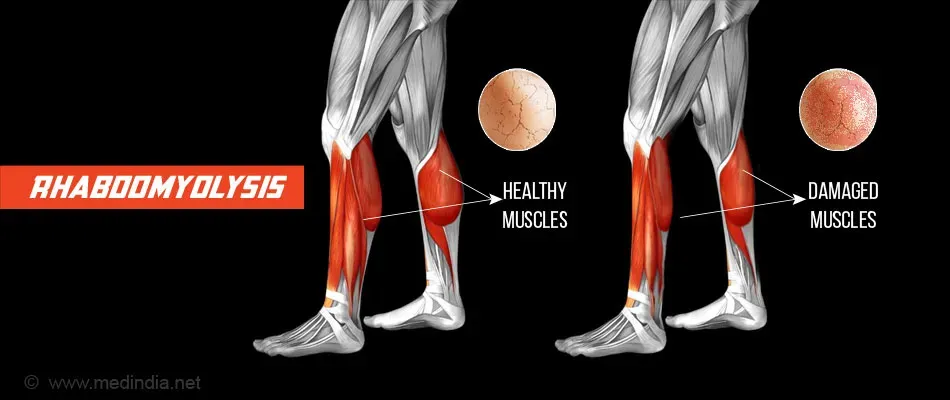Rhabdomyolysis, a potentially life-threatening condition, often stems from intense workouts and inadequate hydration. This disorder occurs when muscle fibers break down, releasing toxins that can overwhelm the kidneys and lead to serious complications such as kidney failure and perilous heart rhythms. Inadequate hydration is a significant risk factor for rhabdomyolysis, illustrating the critical importance of hydration tips for those engaging in demanding physical activities. The alarming reality is that dehydration risks can escalate quickly, particularly during high-intensity training sessions, where muscle pain can signal much deeper issues. Understanding the signs and causes of rhabdomyolysis is vital for fitness enthusiasts, as timely action can prevent severe health repercussions and ensure safe exercise practices.
Often referred to as muscle breakdown syndrome, rhabdomyolysis is a serious medical condition that arises when skeletal muscle gets damaged, resulting in the leakage of myoglobin into the bloodstream. This condition can lead to renal complications, including acute kidney injury, especially in those who push their limits during rigorous workouts. The dangers of this syndrome emphasize the importance of maintaining proper hydration before, during, and after intense physical activity. Additionally, the symptoms may include severe muscle pain, swelling, and dark-colored urine, which can serve as critical indicators for those engaging in strenuous exercise. With awareness and proper hydration strategies, individuals can mitigate the risks associated with this condition and promote safer exercise habits.
Understanding Rhabdomyolysis and Its Risks
Rhabdomyolysis is a serious condition that arises from muscle damage leading to the breakdown of muscle fibers. This process releases harmful substances into the bloodstream, which can overwhelm the kidneys. Symptoms can vary in severity and often include intense muscle pain, weakness, and dark urine resembling the color of cola – a telltale sign that something is severely amiss. In many cases, the underlying cause of rhabdomyolysis can be linked to extreme physical exertion, especially in individuals who may not have adequately hydrated before engaging in intense workouts.
In Gemma Underwood’s case, her alarming experience during a karate class is a cautionary tale for fitness enthusiasts everywhere. Not only did she endure significant physical pain, but she also faced the dire consequences of dehydration that greatly increased her chances of developing rhabdomyolysis. This underscores the importance of understanding the risks associated with intense exercise and the role of proper hydration in injury prevention and muscle health.
Frequently Asked Questions
What is rhabdomyolysis and how is it related to dehydration risks during intense workouts?
Rhabdomyolysis is a serious condition that occurs when muscle tissue breaks down, releasing harmful substances into the bloodstream that can cause kidney failure. Dehydration during intense workouts increases the risk of rhabdomyolysis, as insufficient hydration can lead to muscle damage and hinder the body’s ability to flush out toxins effectively.
How can intense workouts lead to rhabdomyolysis and kidney failure?
Engaging in intense workouts can cause extreme muscle strain and damage, potentially leading to rhabdomyolysis. This condition can release myoglobin into the bloodstream, which may result in kidney failure if not managed properly. Ensuring proper hydration before, during, and after workouts is crucial in preventing this serious complication.
What are the common symptoms of rhabdomyolysis that indicate a need for medical attention?
Common symptoms of rhabdomyolysis include severe muscle pain, weakness, swelling, and dark urine resembling ‘Coca-Cola.’ If these symptoms arise, especially following intense workouts, it is vital to seek medical assistance to prevent potential kidney failure.
What hydration tips can help prevent rhabdomyolysis during workouts?
To prevent rhabdomyolysis during workouts, it’s important to stay adequately hydrated. Drink water before, during, and after exercise, especially if engaging in intense workouts. Monitoring urine color can also help gauge hydration levels; clear or light yellow urine indicates adequate hydration, while dark urine suggests a need for more fluids.
What treatment options are available for rhabdomyolysis and its effects on kidney function?
Treatment for rhabdomyolysis typically involves intravenous fluids to help flush toxins from the body and support kidney function. In more severe cases, if kidney failure occurs, dialysis may be required to filter toxins from the blood. Early intervention and hydration are key to reducing the risk of long-term kidney damage.
Can muscle pain from intense workouts be an early sign of rhabdomyolysis?
Yes, muscle pain after intense workouts can be an early sign of rhabdomyolysis. If the pain is severe and accompanied by symptoms such as weakness and dark urine, it is crucial to seek immediate medical attention to assess for potential muscle breakdown and kidney damage.
| Key Points | Details |
|---|---|
| Definition of Rhabdomyolysis | Condition where damaged muscles break down and release toxic substances into the bloodstream, potentially leading to kidney failure and heart problems. |
| Symptoms | Severe muscle pain, weakness, and dark urine resembling Coca-Cola. |
| Risk Factors | Dehydration, especially during intense workouts, increases the risk. Lack of adequate water intake can lead to severe muscle damage. |
| Treatment | Intravenous fluids and salts in the hospital to flush out toxins; dialysis may be necessary in severe cases. |
| Case Study – Gemma Underwood | 41-year-old woman diagnosed after karate class; emphasized the importance of hydration before workouts. |
| Case Study – 20-Year-Old Man | Developed kidney failure after a 2000 squat challenge; illustrates risks of extreme workouts without proper hydration. |
Summary
Rhabdomyolysis is a serious condition that arises from muscle damage, highlighting the crucial importance of staying hydrated during physical activity. The alarming accounts of individuals such as Gemma Underwood serve as a reminder of the potential dangers of dehydration, particularly during intense workouts. Symptoms such as severe muscle pain and dark urine should not be ignored, and timely medical intervention is essential. To reduce the risk of rhabdomyolysis, always ensure adequate hydration before, during, and after exercise to protect your muscles and overall health.

